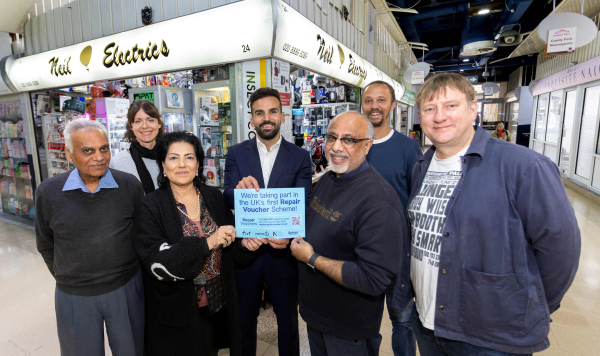The pandemic, new tech and rise in awareness drive clothes swapping and sharing amongst young Brits
From designer fashion rentals to clothes-swapping circles, sharing clothes shifted up a gear in 2020 with clothes swapping set to be one of the big fashion trends of 2021, driven by fashion and eco conscious Gen Z and Millennials. This predicted shift to thrift has been accelerated by the pandemic amongst younger digitally switched-on consumers aged 16-30. According to a new survey carried out by Censuswide* on behalf of the North London Waste Authority (NLWA):
- 1 in 2 Millennials (25-30) and Gen Z (16-24) bought second-hand, swapped or borrowed more in 2020 than 2019
- 1 in 5 Gen Z belong to a virtual swap group
- A third of Gen Z have been re-wearing clothes more and over a quarter of all respondents (26%) intend to do this more
Committed to helping people find ways to live more sustainably, NLWA encourages consumers to Reduce, Reuse and Recycle and recently ran a series of virtual clothes swapping events. This approach is backed up by the influencer marketing platform Wearisma, which found a 47% increase in engagements for #clothesswap content in Q2 2020 compared to Q2 2019 across all key social media platforms.
Green is not yet the new black and fast fashion is fighting back hard – just look at Black Friday £1 bikinis from big retail brands, but market research for 2020 both pre and post COVID-19 pandemic points to the fact that second-hand fashion is the fashion sector’s biggest growth area. In June, US consignment company thredUP’s 2020 Resale Report predicted that the value of the second-hand clothing market can be expected to trump that of fast fashion by the end of the decade, and 20% of UK citizens say the pandemic has changed their approach to fashion.
Chair of NLWA Cllr Clyde Loakes said: "We ran our first clothes-swapping events in north London in 2013 and we’ve seen appetite for them grow and grow. Attendance at the first events was 338 people, but last year’s events saw over a thousand people coming through the door.
“It is encouraging that young people are realising they need to be more sustainable, but we cannot afford to lose momentum on tackling the climate emergency. Clothes swapping is invaluable. It’s inclusive, free, and is definitely a step in the right direction. We need to wake up to the fact that endless consumption is taking its toll on our planet.”
Interestingly only 13% of those polled said they wouldn't wear clothes someone else has worn before, (11% of Gen Z), which means 87% are happy to do so. This is good news for sustainability. After all, the most sustainable fashion we own is in our wardrobes.
Commenting on the shifting sector and the survey findings, Fashion Psychologist Shakaila Forbes-Bell said:
“Without places to go, the goal of getting dressed has evolved from ‘how does this make me look’ to ‘how does this make me feel’. With more people getting clued up about sustainable fashion practices than ever before, the ‘feel-good’ dimension has extended beyond physicality. When wearing clothes, people now want to feel good on a personal level and know that they aren’t contributing to our growing environmental problems”.
“At the same time, the pandemic has caused a drastic decline in mental wellbeing which makes it easier for people to seek instant gratification through fast fashion purchases. 53% of young Brits surveyed admit to buying more new clothes in 2020 than in 2019. There is a neurological basis for so-called ‘shopper’s high’ and research proves that we experience a rush of the feel-good hormone dopamine when we purchase something shiny and new. During particularly trying times it’s no wonder that people seek retail therapy.
“Unprecedented times result in complex behavioural patterns. The desire to be more sustainable is coinciding with the desire to ‘fill the void’ with clothing purchases. Similarly, the desire to ‘stand out from the crowd’ with the help of unique thrifted clothing purchases is coinciding with the desire to ‘belong’ and wear the latest styles that flash on your social media feed. Fast fashion has always been pretty resilient but the rising interest in sustainable fashion is poised to shake its foundation.”
With the economic fallout of COVID-19, the climate crisis and the growing numbers of Gen Z coming of age, the continued growth of thrifting seems assured.
NLWA Top Tips on Reducing Textile Waste:
- Reuse - Find your closest charity shop or clothing bank where you are in north London with the Charity Retail Association’s search tool. Join swapping events or swap with friends and family.
- Removing stains - Taking care of clothes helps them stay in good condition and last longer. Search online for tips on getting rid of all kinds of stains.
- Repairing and altering clothes - Repairing or altering clothes can bring them back to life and save money. Check out NLWA’s guides on how to adjust a seam, repair an edge, sew on a button or repair a hole. If you don’t feel confident to alter a garment, or if it looks complicated, there are lots of local professional alteration services available.
- Textile recycling - When clothes and other textiles cannot be repaired, they can be reused or recycled. It’s always best to try to repurpose these in the first instance, such as using them as dust cloths. Where reuse is just not an option, textiles can be taken to your nearest reuse and recycling centre or visit Recycle Now to find the nearest bank.
- Buy sustainably - All of this doesn’t mean you can’t treat yourself every now and again, but there are more sustainable options around, and they might save you money too. Try browsing your local charity shop or vintage clothes shops for some bargains, or even sites like Ebay, Gumtree or Freecycle for good value or freebies. Or, for special occasions you can find local hiring companies on Love Your Clothes.
More info on NLWA's Reduce and Reuse Clothing page.





